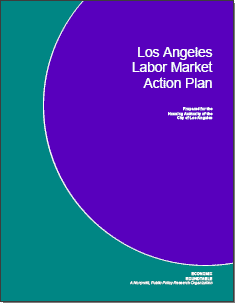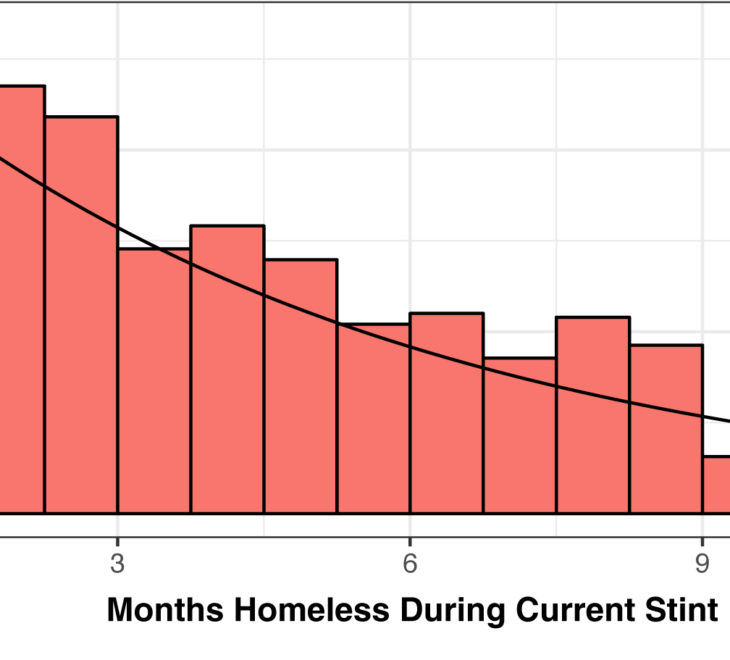 Overview
Overview
This report explores opportunities for residents of the Housing Authority of the City of Los Angeles to obtain sustaining employment. Data and strategies are also applicable to other of the city’s working poor. Highlights of the report include:
- Earnings of residents who were welfare-to-work participants grew from the fourth quarter of 1994 through the end of 1999. In 1999 it became convincingly evident that earnings had risen above the highest level in these workers’ previous earnings histories. This important news demonstrates that aided workers have made tangible progress toward self-sufficiency.
- Despite this progress, only 32 percent of residents who were in the labor market for five or more years had earnings above the poverty threshold of $13,424 for a single parent with two children.
- Residents with higher levels of education and the ability to speak English demonstrated the greatest success in moving toward self-sufficiency.
- The “space economy” of Los Angeles is divided into (a) service areas that extend westward from downtown to the Westside and the south San Fernando Valley, and (b) manufacturing areas that extend south of downtown to the harbor, and northwest into the north San Fernando Valley. The city’s seven planning areas have distinct industry profiles and labor markets
- Industries that are most likely to have job losses that are synchronous with an economic downturn include restaurants, medical and dental offices, legal services, and hotels. Industries that are counter-cyclical include telephone communications, commercial banks, and department stores. Industries that are least cyclical include grocery stores, newspapers, and higher education.
- This report provides tools for identifying, measuring, and managing risks in employment and economic development programs. These risks include possibilities of: declining employment, sub-poverty wages, over-concentration in a handful of industries, industry volatility, excessive costs to create jobs, and jobs that are inaccessible to entry-level workers.
- The ten most promising entry-level occupations that require one year or less of training and 12 years or less of schooling, pay average annual wages of $25,000 or more, and grew at least 5 percent from 1997 to 1999 are: Adjustment clerks; Bill and account collectors; Billing, cost, and rate clerks; Bookkeeping and accounting clerks; Bus drivers; Customer service representatives – utilities; Industrial truck and tractor operators; Sales representatives, non-scientific; Truck drivers, heavy; and Typists, including word processors.
Purpose
This report was prepared to help Housing Authority residents make better job connections in the city’s vast and complex labor market. It offers a strategic action plan for job training and economic development that will increase access to living wage employment. The challenge of achieving self-sufficiency in a changing and increasingly polarized economy is one that residents share with other low-wage workers. Data and strategy recommendations in this report are also applicable to other of the city’s working poor.
This analysis of the city’s economy is, to the best of our knowledge, unprecedented in three ways:
- Quality of Data – The employment and payroll records of every employer in the city along with very detailed data about occupational and wage structure within each industry were analyzed to produce highly detailed and reliable information about the local economy. This information was geocoded to analyze labor markets in different areas of the city.
- Focus on the Economic Self-Sufficiency – The location, skills and needs of Housing Authority residents and other low-wage workers have guided the development of strategies focused on raising the floor of the labor market and increasing the mobility of low-wage workers into sustaining jobs.
- Operationally Relevant – This data has been developed with an eye toward making it useful in strengthening the day-to-day operations of job training and economic development programs.
Any actions that successfully improve the quality of employment for any group of low-wage workers are likely to benefit low-wage workers in general and the region as a whole. Accordingly, we recommend that the Housing Authority encourage other organizations to join in implementing the strategies for economic growth and worker training recommended in this report. Ultimately, it is a single labor market and anything that improves the overall quality of jobs benefits all workers.
We would like to recognize the Housing Authority of the City of Los Angeles for its leadership in supporting development of this labor market action plan. Their recognition of the need for this strategic information, willingness to support development of the data, and interest in using the data to strengthen programs is far-sighted and innovative.
Findings
EMPLOYMENT OUTCOMES
Half of the working-age heads of households receiving shelter through the Housing Authority had earned income on which payroll taxes were reported in 1999. Sixty percent of residents with jobs were employed in all four quarters of 1999. By applying the full-time employment rate of 60 percent to the overall employment rate of 49 percent we find that 29 percent of residents had full time employment in 1999.
The average annual earnings of Housing Authority residents who found work in 1999 was $10,388. Employment rates and earnings were similar for Section 8 and public housing residents.
There was a dramatic increase in earnings for workers who were employed more continuously. Residents with earnings in all four quarters of 1999 earned over three times as much per quarter as those with earnings in just one quarter. The likely explanation is that greater continuity of employment is associated with more full-time and less part-time work as well as advancement to better-paid positions. It is clearly important to help residents build lasting connections with employers.
A comparison of younger workers to older workers found that there was no upward progression of earnings for older workers, as one would hope to find based on progressively stronger work histories and skill development among persons who have been in the labor force for longer periods of time. Helping residents advance their careers is important for encouraging higher rates of labor force participation.
Looking at the entire decade of the 1990s, growth in the earnings of employed residents became apparent in the fourth quarter of 1994 and continued through the end of 1999. The increase in earnings above the highest level in these workers’ previous earnings histories became convincingly evident during 1999 and is important news. This new information provides encouragement that it is possible to see tangible progress toward self-sufficiency in the employment outcomes of aided workers. The average earnings of residents who worked in 1999 was the highest it has been in the past decade. Still, despite this progress, only 32 percent of residents who had been in the labor market for five or more years had earnings above the poverty threshold of $13,424 for a single parent with two children.
Residents with higher levels of education and the ability to speak English demonstrated greater success in moving toward self-sufficiency. Twenty percent of residents in the group with the most positive earnings trajectory had at least some college education, and 58 percent had a high school diploma or some college. In contrast, 64 percent of residents with no earnings lacked a high school diploma or had limited English ability.
The average working-age resident had occupied HACLA (Housing Authority of the City of Los Angeles) housing for a little over four years. There is a close connection between the geography of poverty and the distribution of HACLA households. Eighty-three percent of HACLA households in public housing units are in high-poverty neighborhoods. Almost all of the city’s major housing developments are in high-poverty neighborhoods, as are most of the smaller public housing developments. While Section 8 households are more dispersed, 50 percent of these households are located in high-poverty neighborhoods.
The long-term employment outcomes of residents from 1990 through 1999 show a significant increase in employment levels among HACLA heads of household. However, most work has been found in industry sectors where there are poor prospects for earning sustaining wages. HACLA workers who had the best paying jobs were those who have been able to gain entry into industries with higher wage scales and more demanding employment criteria.
Workers who were in the same industry for three years had significantly higher earnings than workers who migrated among industries. This suggests that unless workers are in a very low-wage industry it is advantageous for them to develop industry-specific skills and advance within an industry.
Within the city, three areas that were home to 59 percent of HACLA workers had particularly acute job shortages. These areas were East and South Los Angeles, and the Harbor area. It appears that at least half of the workers residing in these areas had to commute to other areas to find work. Central and West Los Angeles, and South and North San Fernando Valley were home to 41 percent of HACLA workers and had higher relative availability of jobs.
A majority of HACLA workers found jobs in the areas where they lived, although many workers made significant journeys to reach their jobs. There were distinct geographic variations in wages earned by HACLA residents that reflect the effects of high concentrations of low-wage workers in pulling down the average earnings of the overall workforce some areas of the city. These findings support two programmatic directions. First, it is beneficial to support worker mobility either by providing transportation resources or by helping workers relocate to areas with better employment prospects. Second, it is beneficial to support HACLA workers in acquiring the skills, basic knowledge and work experience that will enable them to reduce the disparity between their earnings and those of the overall labor force.
The ability to read, write, listen, and speak in English is an essential requirement for most jobs that pay annual wages above the poverty threshold. There do not appear to be any industries in which workers with limited English ability can expect to earn above-poverty wages.
THE REGIONAL ECONOMY
Through the 1990s, the Los Angeles region continued to experience a major restructuring of local labor markets. The changing industry structure determines the types of jobs available to workers. Information about the region’s industry structure has strategic value in developing plans for job training, placement, and creation that will benefit residents.
HACLA residents and the working poor in general are highly concentrated in low-wage routine services, and public services. For example, 46 percent of employed HACLA residents in 1999 worked in routine services, compared to 27 percent of all workers in Los Angeles County. Public services accounted for 26 percent of HACLA employment, and 18 percent of all employment in public services. Labor markets for entry-level work tend to be highly localized. Different industry mixes and patterns of employment change will contribute to alternate strategies for job training and economic development in different areas of the city.
The City of Los Angeles has a complex metropolitan economy, and different areas of the city have their own industry profiles and distinct local labor markets. For example, the Central Los Angeles planning area combines a low-wage manufacturing sector dominated by downtown apparel factories, a high-wage service sector centered on Bunker Hill, a public administration sector based in the civic center, and firms in the motion picture industry located in Hollywood. The Westside has a diverse service-based economy, with knowledge-intensive services employing 23 percent of the workforce and the transportation industry based around LAX employing one in every six workers in the area. In the San Fernando Valley, the southern area specializes in service firms strung along Ventura Boulevard and clustered in Warner Center, while the northern area has a high concentration of employment in manufacturing and wholesale trade. Employment in the hard-hit aerospace industry actually grew in the North San Fernando Valley between 1997 and 1999. The Harbor area specializes in manufacturing, wholesale trade, and transportation and warehousing. In the largely residential planning areas of East Los Angeles and South Los Angeles, almost two in every five workers is employed in either manufacturing or health care and social assistance.
We can think of the “space economy” of the City of Los Angeles as divided into (a) service areas that extend westward from downtown Los Angeles on either side of the Hollywood Hills and Santa Monica Mountains, to Westside Los Angeles and the south San Fernando Valley, and (b) manufacturing areas that extend south of downtown Los Angeles to the Harbor, and northwest of downtown into the north San Fernando Valley.
There were 1,324,500 workers employed in the City of Los Angeles during the second quarter of 1999. The city’s employment grew 4.5 percent between the second quarters of 1997 and 1999. The service areas include the planning areas of Central Los Angeles, Westside Los Angeles, and South San Fernando Valley. In each of these areas, less than 10 percent of the workforce is employed in manufacturing (only 3 percent in the Westside), and over 20 percent is employed in knowledge-intensive services. Most of the remaining workforce is employed in routine and public services. The manufacturing areas include East Los Angeles, South Los Angeles, Harbor Area, and North San Fernando Valley. In each of these areas, about 25 percent of the workforce is employed in manufacturing, and less than 10 percent is employed in knowledge-intensive services. These areas also have considerable employment in public services.
Overall, the city’s industry structure is based firmly in the service sectors. In 1999, 84 percent of all non-government employment in the city was in service industries, and 13 percent was in manufacturing. The routine service industries employed 26 percent of the city’s workforce, followed by public services (24 percent), knowledge-intensive services (18 percent), and distributive services (12 percent).
Business outcomes shown by startups and closures as well as growth and decline of employment suggest give specific findings that are applicable to economic development. First, large employers are the backbone of employment and represent a special asset for the City’s economy because of the large number of jobs and above-average wages they provide. Second, there are significant risks for both workers and investors associated with getting a new business started, especially if it is a single-site new start-up. Third, there is less risk in opening a new site of an existing business than in trying to get a stand-alone startup underway. Fourth, the lowest-risk form of job creation is through expansion of an already established employer. Fifth, the employer community is highly diverse, varying by industry, size, type of ownership, business trajectory, and community environment. The interests and needs of employers are equally diverse.
OCCUPATIONAL ANALYSIS
Occupational structures varied from one part of the city to another. The service-based planning areas – Central Los Angeles, Westside, and South Valley – had relatively low concentrations of production-related jobs, and high concentrations of jobs in most non-production occupational groups.
Central Los Angeles had its highest number and concentration of workers in professional and technical occupations. Managerial, administrative, and clerical occupations were also well represented there. The Westside had the highest concentration of workers in high-wage managerial, administrative, professional, and technical occupations. One in three workers in the Westside in 1998 were employed in these occupations. The South Valley had the highest concentration of sales workers of any planning area.
Employment in the four manufacturing-based planning areas – North Valley, East Los Angeles, South Los Angeles, and Harbor Area – was dominated by production, construction, and material handling occupations, which employed between 35 and 40 percent of the workforce in these planning areas. As a result, concentrations of non-production jobs were below average in each of these areas, with the exception of sales and service jobs in East Los Angeles.
There were significant differences in average annual wages within occupations across the seven planning areas of the City of Los Angeles. Typically, the highest wages were paid in the Westside and the lowest wages were paid in South Los Angeles. This is consistent with differences in local labor market dynamics across the city, with tighter labor markets in the Westside and slack labor markets in South Los Angeles.
The lowest average annual earnings in the city were in the four manufacturing-based areas of North San Fernando Valley, East Los Angeles, South Los Angeles, and the Harbor area. This demonstrates that production jobs are no longer a primary source of middle class incomes in the Los Angeles area.
Thirty-four promising occupations were identified for HACLA residents that: (1) require 1 year or less training, (2) require twelfth grade or less educational skills, (3) pay average annual earnings of at least $25,000, (4) grew by at least 10 percent between 1997 and 1999.
Most of these 34 promising occupations are clerical (15) or production (14). There are five sales occupations, two professional and technical occupations, and two primary occupations. No administrative or service occupations made the list.
OPERATIONAL USES FOR STRATEGIC LABOR MARKET INFORMATION
The most serious labor market risk facing many Housing Authority residents is that they will not be part of the region’s workforce and not make progress toward self-sufficiency. Job training and economic development investments that are made to avert this primary risk bring secondary risks that expenditures will not be well targeted. Secondary risks associated with selecting industries for employment and training as well as economic development programs can be identified, assessed and managed using HACLA’s new data sets.
Secondary risks associated with selecting industries for job training and economic development are that: (1) industries will decline and lay-off workers, (2) workers will receive sub-poverty wages in the industries that employ them, (3) a large population of HACLA workers will be displaced as a result of changing employment conditions in a handful of industries, (4) industry volatility will result in high job turnover, (5) costs-per-job for economic development in an industry will be unnecessarily high, (6) new jobs that are created in an industry will not be accessible to HACLA workers. Identifying and understanding these risks does not eliminate them, but it does provide a tool for comparing risks among industries and choosing the lowest risk options, as well as for managing risks during program implementation.
The resources available for job training and economic development are very small in comparison to market forces. The strategies recommended in this report are based on understanding the City’s strengths and working in harmony with market forces to build on those strengths. It is not realistic to expect that program resources will reverse or fundamentally alter the City’s economic trajectory. It is realistic, however, to expect that thoughtful program strategies can provide slight but consistent nudges toward retaining and expanding industries that strengthen the economy and provide sustaining employment for HACLA residents.
Strategy-driven employment and economic development programs can provide better returns for public investments in helping HACLA residents become self-sufficient and independently housed. The Housing Authority of the City of Los Angeles is serving a broad range of public interests that extend to the entire City by creating and utilizing this information.
The primary goal of this report and accompanying data is make it possible to improve the match between workers and jobs. Important steps in helping workers find satisfactory jobs include:
- Identify Career Possibilities: Gather information about job seekers in a format that parallels the kinds of data that is available about occupations. This includes: determining the specific occupations in which a job seeker has worked, identifying the job seekers’ strengths and weaknesses in previous jobs along with skills, level of education, work interests, goals, and any impediments to finding and keeping a job. For persons without previous work experience, interest inventory tests and occupational profiles can be used to identify potential occupations in which they might seek employment.
- Identify the Most Feasible Occupation: Having identified a set of occupations that offer career possibilities for an individual job seeker, the next step is to analyze local job availability and wages in the occupations in order to identify the optimal occupation for the individual. The information provided in this report and accompanying electronic files can be used to assess occupations based on size and wages in each of the seven planning areas. Industry data provided in the report can be used to understand trends in the industries that employ the most workers in an occupation.
- Occupational data can be used to identify specific skills and educational and training requirements for occupations.
Identify Training and Education Needs: Once an appropriate occupation has been found for a job seeker, training and education needs have to be evaluated. Occupational data should be used to identify the skills and knowledge areas that are most important to employers, as well as the levels of skill and knowledge that are needed. - Find a Job: The industry-occupation matrix that has been provided in an electronic file can be used to identify the industries that employ workers in the target occupation and to rank those industries based on the number of jobs they provide and their average wages for the occupation. Industries employing the most workers and paying the highest wages should be given first priority in the job search process. Next, the industry employment tables presented in the report can be consulted to identify employment in the target industry in the planning area in which a job seeker is looking for a job.
There is a diverse array of occupations and industries that have the potential to provide sustaining employment. These opportunities vary from one area of the city to another. Armed with detailed knowledge about local labor markets as well as the skills, interests, and abilities of jobseekers, HACLA can play an increasingly important role in helping the city’s working poor residents achieve self-sufficiency.
Recommendations
The following seven actions are recommended based on the findings and conclusions from this report.
- Use the labor market information and procedures provided in this report to assist Housing Authority residents in developing employment plans, obtaining training, and finding jobs that match their skills, interests and potential to learn with the best available positions in labor market.
- Use the analysis of industry characteristics and risk factors provided in this report to screen and evaluate industries and employers when developing employer-based training and employment programs for residents.
- Use the analysis of industry structure, geography, growth, compensation, and risk factors provided in this report to plan and undertake job creation initiatives to create new employment opportunities for residents.
- Build transitional safety nets for HACLA residents. Increases in earnings alone are likely to enable only a limited number of residents to achieve housing independence. The top 14 percent of workers who had been in the labor force five or more years still had average earnings within the eligibility parameters for HACLA housing. A strategy of providing a “safety net warranty” should be explored. The concept of the warranty is to assure residents that their basic survival needs will be met if they suffer setbacks after moving out of subsidized housing, thereby making it safer to move to new neighborhoods and free up units for new families that need shelter.
- Update the labor market information in the report at least once a year so that the data accurately reflects changes in the city economy. In addition, use operational experience with the data to validate its reliability as well as to provide feedback about areas where the data should be improved.
- Strengthen HACLA’s internal data collection procedures so that this information can be increasingly useful in analyzing and developing employment programs. This should include obtaining accurate Social Security numbers from residents, improving the quality of coding for such characteristics as language and ethnicity, and obtaining information about level of education and employment history.
- Expand the use of the labor market information in this report by making the report available to other interested organizations and the public.
Chapter Headings
- Executive Summary
- Overview
- Profile of Housing Authority Residents and Employment Outcomes
- Industrial and Geographic Influences on Employment Outcomes
- Industry Strategies for Training, Job Placement, and Economic Development
- Occupational Analysis
- Career Mobility for Workers with Limited English
- Procedures for Using Labor Market Information
- Conclusions and Recommendations
- Appendix













